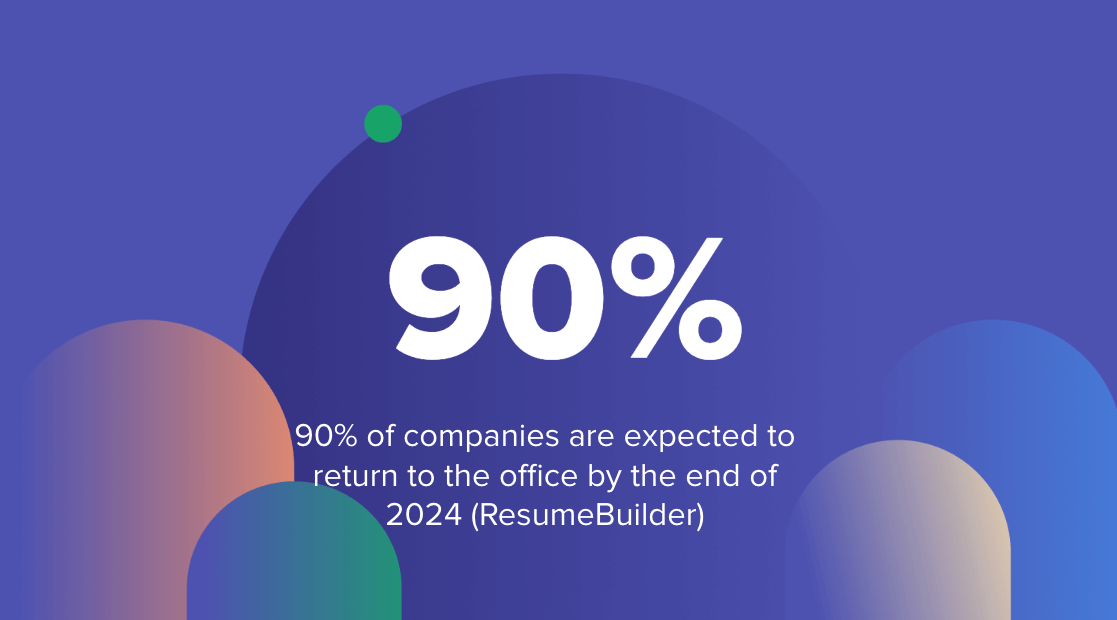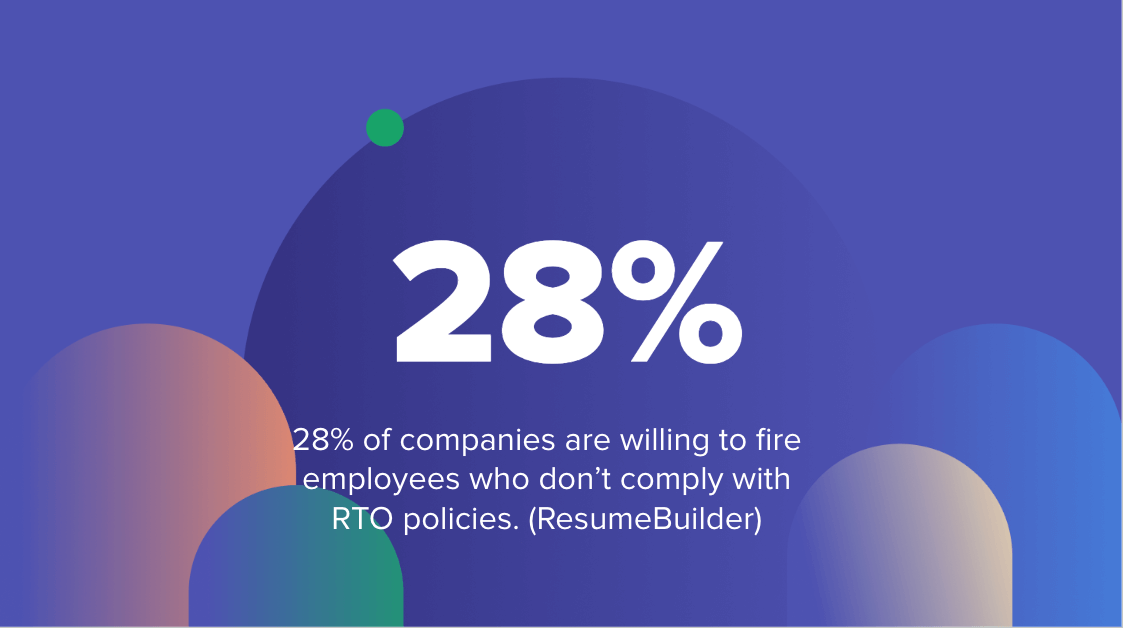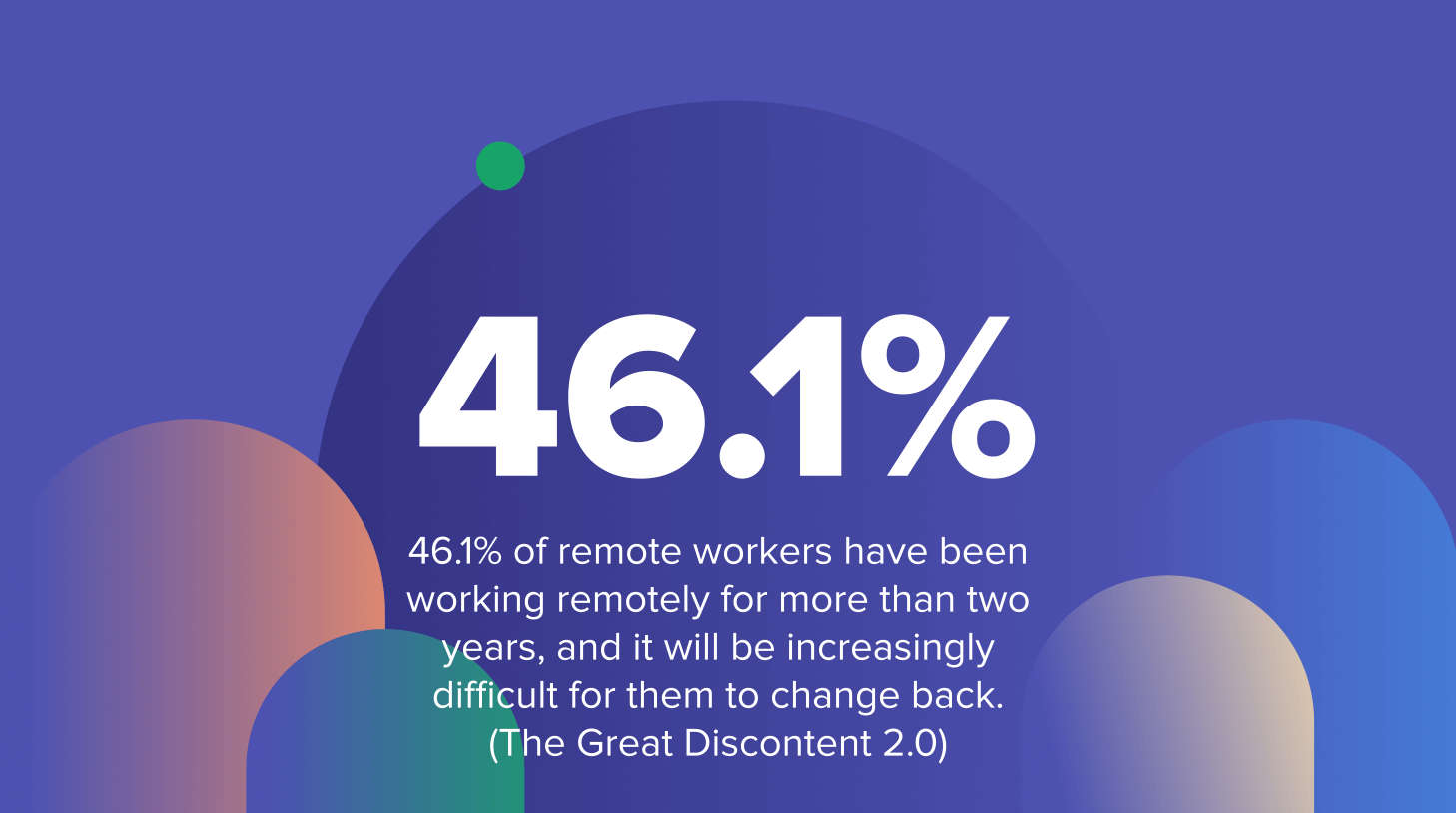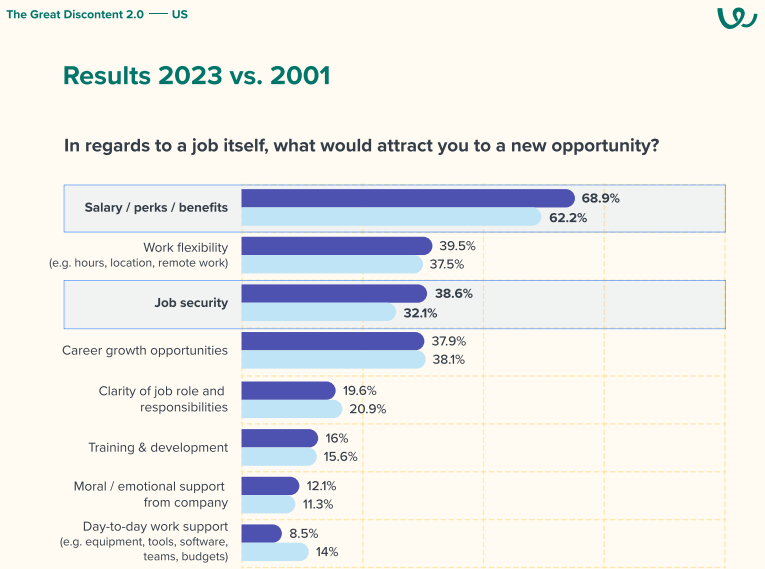Return to office strategy: can RTO harm your business?
What's next for the office? It’s a safe bet that this is your question as an HR professional or company owner at the moment.

The truth is we’re all navigating a mix of uncertainty, evolving employee preferences, and logistical challenges.
Is returning to the office a good option after a long period of remote working? For the higher-ups, maybe it is. But what about the employees?
While our recent data from the Great Discontent in 2023 shows a decline in remote work among US-based workers, down 17 points from 58% in 2021, 46.1% of remote workers have been doing so for more than two years, and it’s increasingly difficult for them to change back.
It’s about time to delve into the various facets of returning to the office, from understanding what it means to the pros and cons, and even the small details of making the transition smooth for everyone.
Contents
What is Return To Office, a.k.a. RTO?
Beyond the obvious interpretation, RTO is about rethinking how we work. The models vary – full-time in the office, a hybrid approach, or a remote-first strategy. The one-size-fits-all approach is long gone, and it’s time to tailor your strategy to fit your team’s needs, unless you’re President Biden, who is urging federal workers to return to the office starting this fall.
Understanding the nuances of these models is crucial. A full-time return might work for some roles but could be disastrous for others.
A hybrid model offers flexibility but requires robust management to ensure productivity.
Remote-first is the most flexible but could lead to feelings of isolation among team members – especially newer ones.
Each model has its pros and cons, and it’s your job to find the best fit.
Will people return to the office now?
Quick answer is no. Obviously.
According to ResumeBuilder, 90% of companies are expected to return to the office by the end of 2024. That’s a significant number, but it doesn’t tell the whole story.

PromoLeaf’s data indicates that 35% of Americans capable of full remote work are choosing that route. So, what’s the output? The answer lies in a blend of employee preferences, company policies and, of course, the ongoing pandemic.
It’s a complex cocktail that requires a nuanced approach. Some employees are eager to return for the social interaction and structured environment, while others have found that they’re more productive at home.
Company policies also play a significant role. Some organizations are adopting a “remote-first” policy, while others are insisting on a full return to in-person work.
The ongoing pandemic adds another layer of complexity, with fluctuating infection rates and varying comfort levels about in-person interactions.
Bring people back to the office
There’s a strong case for bringing people back to the office. Collaboration, team-building, and those invaluable water-cooler conversations between employees are hard to replicate online.
Moreover, 72% of companies say that returning to the office (RTO) has improved revenue.
As a result, returning to the office can benefit both sides.
We know working from home can be a savior when it comes to avoiding huge traffic and saving time – making for a better work life balance according to nearly two-thirds of all respondents in the Great Discontent survey.
But what about your privacy at home? The majority of companies are tracking employees to ensure they are actually working.
However, it’s essential to approach this with sensitivity. The tracking of employees, for instance, can be a double-edged sword.
While it ensures that people are working, it can also create a culture of surveillance if not handled correctly. Transparency about why and how tracking is done can alleviate some of these concerns.
Also, working from home can blur the lines between the estimated time of working and the actual one. Returning to the office (RTO) can standardize working hours and offer a more solid work-life balance.
A recent study shows that more than half (54%) have worked from their bed, and 76% work in pajamas at least one day a week. Nearly one in five (19%) have even worked from the toilet! While it may seem humorous, these stats reveal the blurred lines between work and personal life in a remote setting.
Related: WFH vs. RTO: what really works for your business
Culture of fear doesn’t help anyone
On the flip side, there are valid concerns about rushing back to the office. Employee well-being, work-life balance, and even productivity can take a hit.
A startling 28% of companies are willing to fire employees who don’t comply with RTO policies.

This hardline approach can create a culture of fear and resentment, which is the last thing any of us want.
Moreover, the threat of termination for non-compliance can lead to a toxic work environment. It can cause stress and anxiety among employees, which is counterproductive.
A more empathetic approach that takes into account individual circumstances and needs can go a long way in making the transition smoother. So, how prepared are you to persuade your employees to return back to the office?
How to prepare employees for RTO?
Communication is key when announcing a return to the office. Whether it’s through company-wide meetings, detailed emails, or one-on-ones, clarity is crucial.
A phased approach that allows for flexibility can make the transition smoother.
A return-to-work meeting is a great opportunity to set expectations and address concerns. Key points to cover include safety measures, new office policies, and support systems for employees.
An agenda, a Q&A session, and a follow-up can ensure that everyone is on the same page.
The meeting should be more than just a one-way flow of information. Encourage questions and discussions. This is a significant change for everyone, and people will have concerns and suggestions. Listening to these can provide valuable insights and also make the employees feel valued and heard.
Remember, you’re not just relaying information; you’re setting the tone for the company’s next chapter.
Make the transition smoother
Incentives can go a long way in easing the transition back to the office. According to PromoLeaf, 91% of remote workers think employers should do more to show appreciation.
Whether it’s a revamped break room, flexible hours, or even a small stipend for commuting, little things can make a big difference. Addressing concerns and fears openly can also help in making the transition smoother.
It’s also essential to recognize and validate the concerns that employees may have about returning.
Some may be worried about health and safety, while others may have childcare concerns.
Addressing these issues openly and providing solutions can go a long way in easing the transition.
Flexy is the new normal
As the pandemic has progressed, the initial surge in flexible work options has now settled into a new normal, with many employers considering it as a permanent option.
According to our report, the Great Discontent 2.0, the second most influential factor that would lead someone to consider changing their job is flexibility.
Consequently, It is crucial for employers to allow their teams to have flexibility in their work arrangements, taking into account personal reasons such as family and health priorities.
This may involve offering remote work opportunities, flexible hours, convenient commuting options, accessibility measures, or increased support for family and health-related matters.
Coming back to the office is a complex matter that requires collective decision-making and open dialogue.
It should not be imposed on employees, but rather seen as an opportunity to explore new hybrid work models that align with their preferences.
Instead of creating a hostile environment, let’s use this as a chance to develop incentives that will facilitate a smooth transition for everyone.
Be proactive, be empathetic, and be flexible.
Frequently asked questions
- What is RTO?
- RTO (Return To Office) refers to the strategy of bringing employees back to physical offices after a period of remote work.
- How many US workers are currently remote?
- As of 2023, 46.1% of US remote workers have been working remotely for over two years.
- Why are companies considering RTO?
- Collaboration, team-building, and increased revenue are primary reasons for companies leaning towards RTO.
- How can companies ease the RTO process?
- A blend of clear communication, flexible policies, and addressing employee concerns can simplify the transition.
- Is flexibility the new work trend?
- Yes, flexible work options have become the new normal, with many considering it a permanent shift post-pandemic.





